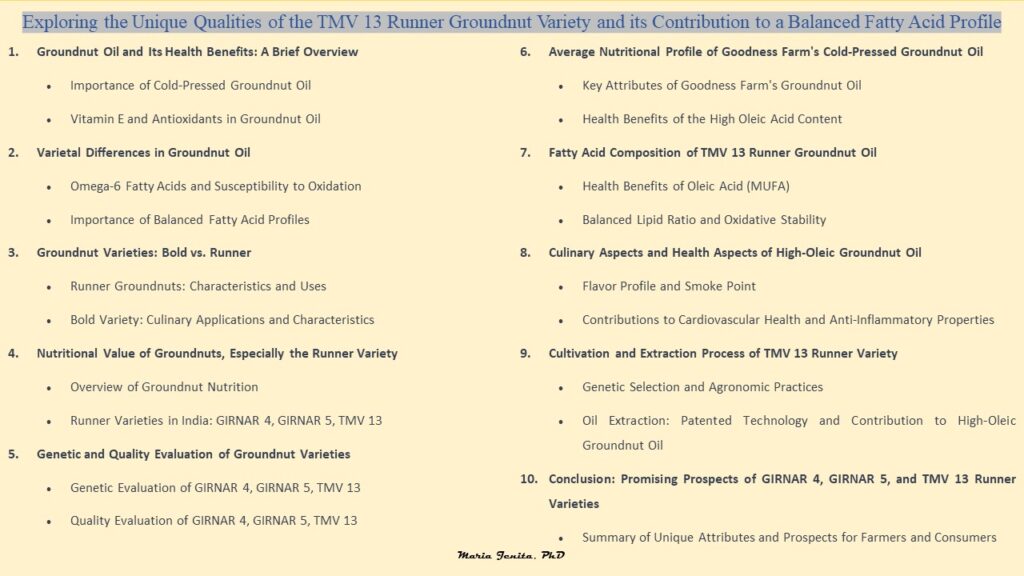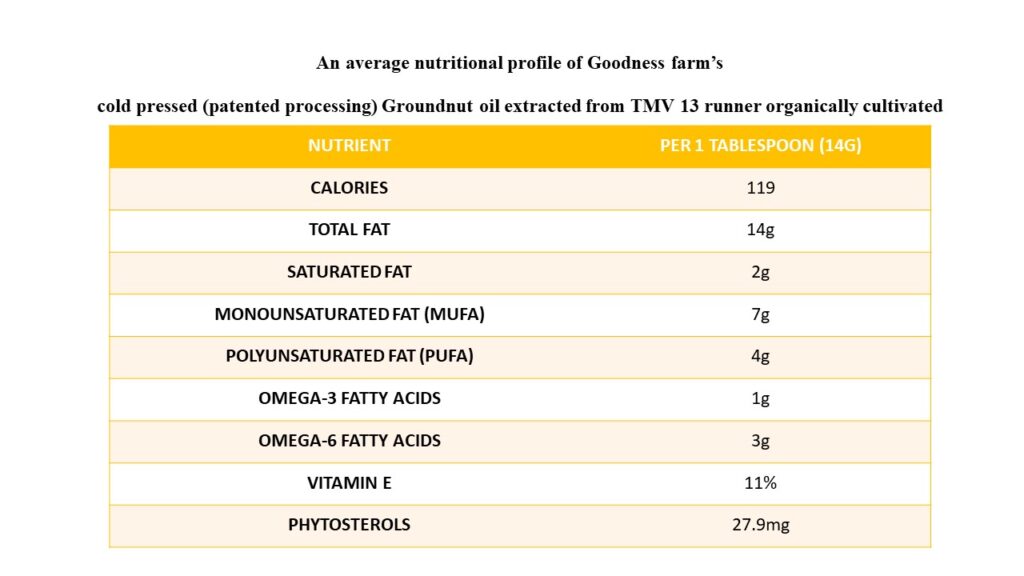Uncategorised
Exploring the Unique Qualities of the TMV 13 Runner Groundnut Variety and its Contribution to a Balanced Fatty Acid Profile

Groundnut oil, also known as peanut oil, is a common and tasty cooking oil, healthier when its cold pressed as Groundnuts being source of vitamin E gets retained. Vitamin E is a fat-soluble antioxidant that helps protect cells from oxidative damage. Research indicates that regular consumption of vitamin E is associated with various health benefits, including immune system support and skin health. A good Groundnut oil contains a variety of antioxidants, including resveratrol, which is known for its anti-inflammatory properties. Research suggests that these antioxidants may contribute to the oil’s ability to combat oxidative stress in the body. Oxidative stress is linked to various chronic conditions, and incorporating antioxidant-rich oils like groundnut oil into the diet may offer protective effects. Studies have delved into the culinary aspects of groundnut oil, examining its suitability for various cooking methods. The oil’s high smoke point, a characteristic that determines its stability at high temperatures, makes it suitable for frying and other high-heat cooking methods without significant degradation of its nutritional components.
Varietal Differences:
Research often emphasizes the importance of considering the specific variety of groundnut oil. Different cultivars may exhibit variations in fatty acid profiles, vitamin E content, and overall nutritional quality. Understanding these varietal differences can aid in making informed choices as there are a couple of things to be careful about when using groundnut oil:
- Omega-6 Fatty Acids: Actually, essential for our bodies, but, too much of them, especially compared to another type called omega-3, can cause some issues. Think of it like having too much of one ingredient in a recipe; here it turns out to be bad for health.
- Susceptibility to Oxidation: Another thing to know is that groundnut oil can change when it’s exposed to high heat during cooking. It’s a bit like how fruit turns brown when it’s cut and left out for too long—it’s not bad, but it’s not as good as when it’s fresh.
Why Does it Matter: Okay, so now let’s talk about these fatty acids. There are three types: MUFA, SFA, and PUFA.
- MUFA (Monounsaturated Fatty Acids): These are the good guys. They’re like the superheroes of the fat world. They help your heart and can lower the bad cholesterol. Groundnut oil has some of these, which is great.
- SFA (Saturated Fatty Acids): These are not terrible, but you don’t want too much of them. They’re like the neutral characters. Groundnut oil has a moderate amount of these.
- PUFA (Polyunsaturated Fatty Acids): Now, these are good, but there’s a balance. Omega-3 and omega-6 are types of PUFA. You want a good mix of both, like a balanced diet. Groundnut oil, unfortunately, has a lot of omega-6, and that’s where the trouble starts.
Why Does the Balance Matter: Imagine your body is like a team, and MUFA, SFA, and PUFA are players. They all have different roles, and for the team to play well, you need the right mix. Too much of one player (like too much omega-6) might make the team not work as well together. It could even cause some ‘inflammation,’ which is like the team not getting along..
Do all the Groundnut and its oil have this imbalanced proportions leading to inflammations in our body..
NO
Starting with the basics of Groundnut varieties- bold and runner (classified based on their, also there’s this hybrid variety of bold runner variety that’s a combination of both).
Runner Groundnuts: Runners are primarily grown for oil production due to their high oil content and consistent kernel size. They are characterized by a relatively uniform shape with two kernels per pod. The name “runner” is derived from the plant’s growth habit, as the flower stalks elongate after pollination, causing the developing pods to be lifted off the ground.
Bold Variety: The term “bold” in the context of groundnuts refers to the size and shape of the kernels. Bold groundnuts are larger and more robust compared to other varieties, making them particularly desirable for certain culinary applications. The boldness of the kernels contributes to a richer taste and texture, making them a preferred choice for roasting, snacking, groundnut meal and peanut butter production. This growth pattern is advantageous for harvesting, as the peanuts are easily accessible, also the kernels are more per pod.
Nutritional Value: Groundnuts, esp the runner variety, are nutrient-dense and provide a good source of protein, healthy fats, vitamins, and minerals. They are also known for their antioxidant properties and may contribute to heart health when consumed as part of a balanced diet.
India has these three runner varieties of Groundnuts that hold an appreciable lipid profile, like GIRNAR 4, GIRNAR 5, TMV 13, renowned for its balanced fatty acid profile.
Genetic and Quality Evaluation of Groundnut Varieties: GIRNAR 4, GIRNAR 5, TMV 13
Genetic Evaluation:
GIRNAR 4:
- Genetic Background: Derived from a lineage known for adaptability and yield.
- Oleic Acid Profile: Inherits characteristics from renowned oleic acid-rich groundnut varieties.
- Disease Resistance: Exhibits robust resistance to common groundnut pathogens.
GIRNAR 5:
- Genetic Origin: Developed through selective breeding for enhanced nutritional traits.
- Oleic Acid Enhancement: Genetic interventions have led to an increased oleic acid concentration.
- Agronomic Traits: Genetics contribute to desirable growth habits and confer adaptability to diverse agro-climatic conditions.
TMV 13:
- Genetic Selection: Derived from a lineage known for adaptability and yield.
- Heritage: Genetic markers indicate a balanced fatty acid profile with a moderate oleic acid content.
- Adaptability: Efficient nutrient utilization.
Quality Evaluation:
GIRNAR 4:
- Oil Quality: Recognized for an exceptional oleic acid profile, exceeding typical levels.
- Seed Size: Uniform seed size and kernel integrity contribute to overall quality.
- Flavor Profile: Mild and palatable flavor suitable for various culinary applications.
GIRNAR 5:
- Nutritional Quality: Enhanced oleic acid content contributes to improved nutritional quality.
- Aflatoxin Resistance: Genetic traits provide resistance against aflatoxin contamination.
- Processing Efficiency: Suitable for oil extraction processes, ensuring high-quality oil production.
TMV (Gn) 13 Runner:
- High Oleic Acid Content: demonstrates good oil quality with a balanced fatty acid composition.
- Uniform Kernel Size: Consistent kernel size enhances processing efficiency and oil quality.
- Oxidative Stability: Balanced fatty acid content contributes to extended shelf life and oxidative stability of extracted oil.
Key Quality Parameters:
GIRNAR 4: Moderately balanced oleic acid profile.
GIRNAR 5: Enhanced oleic acid concentration.
TMV 13: Exceptional PUFA content, a hallmark trait.
The genetic and quality evaluation of GIRNAR 4, GIRNAR 5, and TMV (Gn) 13 Runner underscores their unique attributes, with a specific focus on oleic acid enrichment, disease resistance, and overall nutritional quality. These groundnut varieties present promising prospects for both farmers and consumers, combining adaptability with superior quality traits.

Key Attributes:
– High Oleic Acid Content:
– Dominant MUFA profile, approximately 60% of total fat, showcasing exceptional quality.
– Oxidative Stability:
– Balanced fatty acid composition ensures extended shelf life.
– High oleic acid content enhances stability.
Health Benefits:
– Cardiovascular Health:
– Maintains/elevates HDL levels.
– Balanced Lipid Ratio:
– Maintains a 3:1 ratio of Omega-6 to Omega-3 fatty acids.
– Oxidative Stability:
– Resistance to oxidation ensures freshness and an extended shelf life.
The fatty acid composition of TMV (Gn) 13 runner groundnut oil presents a unique blend, with an impressive 60% oleic acid, 30% linoleic acid, and a minimal 10% palmitic acid. Oleic acid, categorized as a monounsaturated fatty acid (MUFA), takes center stage, playing a crucial role in the oil’s structural stability and associated health benefits.
Health Benefits of Oleic Acid (MUFA):
Oleic acid, constituting a significant 60% of TMV (Gn) 13 runner, actively promotes cardiovascular health. It effectively reduces low-density lipoprotein (LDL) cholesterol (considered ‘bad’) while maintaining or elevating high-density lipoproteins (HDL) levels (‘good’). This high oleic acid content results in an impressive O/L ratio exceeding 20, emphasizing its cardioprotective properties.
Balanced Lipid Ratio:
The lipid ratio is balanced, 3:1 ratio of Omega-6 to Omega-3 fatty acids. This equilibrium not only supports heart health but also effectively combats inflammation, aligning with the principles of a health-conscious diet.
Oxidative Stability:
To ensure a prolonged shelf life, the groundnut oil undergoes a sophisticated production process that minimizes susceptibility to oxidation. The high oleic acid content, being 50 times less prone to oxidation, imparts remarkable oxidative stability, maintaining the freshness of Goodness Farm’s groundnut oil.
Culinary Aspects:
- Flavor Profile: Mild and pleasant, offering versatility in culinary applications.
- Smoke Point: High, suitable for various cooking methods esp deep frying without compromising nutritional integrity.
Health Aspects:
- Cardiovascular Health: Active contribution to heart health through LDL reduction and HDL maintenance/elevation.
- Anti-Inflammatory Properties: Balanced Omega-6 to Omega-3 ratio supports anti-inflammatory responses.
- Extended Shelf Life: Heightened oleic acid content ensures both oxidative stability and an extended shelf life for groundnut products.
Cultivation and Extraction Process: Cultivation of TMV (Gn) 13 Runner Variety:
- Genetic Selection: Emphasizes a high oleic acid profile.
- Agronomic Practices: Optimized intercropping conditions and precise crop management to enhance oleic acid development.
Oil Extraction at 3 RPM in Ceramic Expeller (patented):
- Patented Technology: Minimizes heat generation during extraction.
- Low RPM Operation: Ensures a gentle process, preserving nutritional integrity.
- High Oil Yield: Efficient extraction maintains a high concentration of oleic acid.
Contribution to High-Oleic Groundnut Oil:
- Oleic Acid Enrichment: Optimal conditions for extraction contribute to the remarkable oleic acid concentration.
- Minimized Oxidative Stress: Slow and gentle extraction minimizes oxidative stress, ensuring freshness over time.
Thus, the harmonious synthesis of scientific precision and culinary excellence defines Goodness Farm’s high-oleic groundnut oil. This distinctive oil, derived from the TMV (Gn) 13 runner variety and extracted with a ceramic cold expeller, sets a new standard for health-conscious and premium culinary experiences.
This claim is substantiated through the assessment and study of diverse groundnuts and their oil profiles across India, including an analysis of commercially available groundnut oils, whether cold-pressed or physically extracted.”
MJ, PhD
Food Technologist
